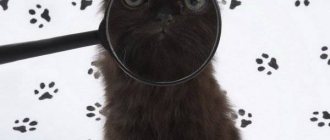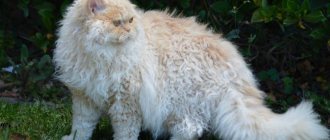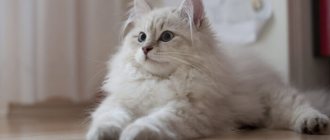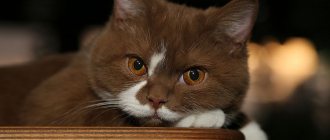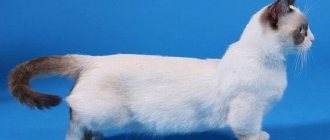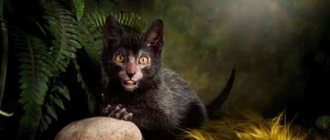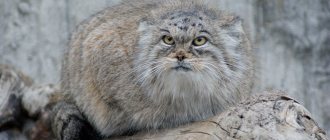Russian Kote
- Fact 1:
The Don Sphynx is one of the most exotic breeds bred by Russian breeders - Fact 2:
The Karelian Bobtail is a Russian aboriginal breed, bred in St. Petersburg in the 80s. last century. - Fact 3:
The Kurilian Bobtail is another breed that belongs to the aboriginal group. - Fact 4:
Russian Blue is one of the oldest breeds bred in Russia. Mentions of it date back to the reign of Catherine II.
Cats have been constant companions of humans for many centuries. In some countries they were considered sacred and inviolable, and were valued more than gold. In case of natural disasters or danger, they tried to save them first.
In other cultures, cats were only household guards against rodents or small predators. Sailors loved these pets very much. They often took cats on long voyages to protect food supplies from rats.
In Russia, cats have been revered for a long time. This is the only animal that is not prohibited from appearing in the temple. Nowadays, graceful pets, like many centuries ago, are credited with many wonderful properties: the ability to heal diseases and foresee disasters. Indeed, after caressing a purring friend or stroking soft fur, you can forget about all your problems.
Key Features
“Native” cats were always taken as the basis for breeding; some individuals were crossed with wild species of felines, which was reflected in their appearance and character.
An important feature of Russian cat breeds is also their short pedigree (with the exception of the Siberian). It is quite difficult to find a cat with a history of more than four generations; for this reason, some cat breeds are not considered “canned”.
Very often, purebred kittens are sold without documents, as a result, there is a high risk of purchasing an outbred individual. When purchasing a purebred animal, you should always ask for documents and pedigree.
Ural rex
The Ural Rex is a breed with a rather unusual appearance. The peculiarity of cats is long wavy hair. The muzzle is slightly elongated, with well-defined cheekbones and a strong chin. Eye color always matches the main color.
In addition to their original appearance, the Ural Rex also has an interesting character. They are not picky, easy to train, and get along well with people and animals. And their fur does not cause allergies.
Russian blue cat
This breed is considered one of the most famous and beloved in the world. Its main value lies in the absence of participation of breeders in its breeding; humans only supported the population. According to legend, several centuries ago, Russian English sailors stopping at the port of Arkhangelsk took cats with a unique gray-blue tint of fur on board as a souvenir.
The coat is short, thick, the shade is always the same - gray-blue, slightly shimmering, the character is soft and calm, the kittens are affectionate, playful, sometimes cats can show willfulness and stubbornness.
Prices vary between 8-35 thousand rubles.
dalnevostochnyy_leopard_-_mihail_kolesnikov.jpg
Far Eastern leopard.
Photo: Mikhail Kolesnikov Since 2011, the Russian Geographical Society has supported the Far Eastern Leopard project. Its goal is to study the state of predator populations, as well as develop the infrastructure of specially protected natural areas within its range.
In order to preserve the unique natural territories of Russia where the Far Eastern leopard lives, and thus save this subspecies, an autonomous non-profit organization “Far Eastern Leopards” was established in 2011. It cooperates with the Leopardovy Nature Reserve, the Kedrovaya Pad Nature Reserve and the Land of the Leopard National Park, created in 2012.
Irbis, or snow leopard
The snow leopard, or snow leopard, is the only species of the snow leopard genus and the only large representative of the cat family that lives in the highlands of Central Asia. The habitat of the snow leopard lies in the upper and middle zone of the mountains of Central and Central Asia (Himalayas) and Southern Siberia. This range includes the territories of Russia, Afghanistan, Burma, Bhutan, India, Kazakhstan, China, Kyrgyzstan, Mongolia, Nepal, Pakistan, Tajikistan and Uzbekistan. The species is endangered. According to various estimates, about 7 thousand snow leopards live in the wild, while in Russia there are only 150–200 individuals. In the Red Book of the Russian Federation, the snow leopard belongs to category I. This predator is also listed in the Red List of the International Union for Conservation of Nature and in Appendix I of the Convention on International Trade in Endangered Species of Wild Fauna and Flora (CITES). In 2011, the state nature reserve of federal significance “Pozarym” was created, on the territory of which the reintroduction of young snow leopards is carried out.
Siberian
The Russian cat breed originated in the Siberian forests as a result of crossing domestic breeds with wild steppe ones. Siberian cats are distinguished by their strong physique and thick, dense fur coat; due to these two factors, individuals look like real giants.
The weight of an adult animal can reach 12 kg, the size of cats is somewhat smaller, but they still remain quite strong, and at the same time harmoniously built cats.
The main feature of the breed is the coat; it is long, the undercoat is short, dense and thick, perfectly protecting the individual from the cold. The obligatory attributes of the breed are thick pants and a collar, hair between the toes, tufts on the ears; Siberian cats are distinguished by self-sufficiency, intelligence, strong and bright character.
A Siberian kitten can be bought for 10 thousand rubles.
Cat Bridge
He is also called the "Bridge Cat". Back in 2015, security guards at the Crimean Bridge construction site sheltered an abandoned skinny red kitten and settled it in their cabin. So the cat became a “controller” monitoring every stage of construction, the mascot of the Crimean Bridge. Mostik has gained a lot of weight over the past 5 years; his favorite dishes are dumplings, pancakes and shrimp.
In December 2021, the bridge across the Kerch Strait was completed. Mostik will inspect train traffic for a few more months and then move to a new location. He has already received offers of “employment,” as reported in the information.
Mostik regularly blogs. Here you can always see his latest photographs. And some fans recommend making a monument to the inspector cat, cast in bronze, before entering the bridge.
Neva Masquerade
The Neva Masquerade is considered a descendant of the Siberian cat; the name appeared due to the unusual color of its face, as if it were wearing a carnival mask.
Another advantage of the breed is its non-standard color-point coat with bright eyes. Neva cats are very affectionate and sensitive, taking their place among favorite pets.
The cost starts from 2 thousand rubles. for a kitten without a pedigree and ends at 25 thousand rubles.
Russian white, black, tabby cats
The birth of the Russian White , Black and Tabby Cat began in Australia on May 4, 1971. The decision to develop a new breed was made by Dick and Mavis Jones, owners of the Myemgay cattery, who were breeding and studying Russian blue cats.
In her article on the problem of breeding white Russian cats, Mavis Jones talks about the difficulties they had to face. To avoid deafness, which affects most white cats, a white cat was mated with a Russian Blue cat.
I had to convince skeptics that in Russia there are not only blue cats, but also all other colors, just like everywhere else in the world.
In addition, the RAS (Royal Agricultural Society) has banned experiments with the Russian Blue breed, since this breed is one of the few in the world that still manages to preserve its original type, uncorrupted by human intervention.
“Russian Blue breeders did not support our idea,” says Mavis Jones. But we were adamant. We read that white Russian cats live in the Siberian snows, and we saw photographs of the cats themselves - beauties with sparkling green eyes, slender bodies and long legs, with luxurious double “plush” fur, which was not blue, but sparkling white. In fact, we did not invent this breed. We aimed to introduce the existing Russian cats into Australia and increase their numbers so that these beautiful animals are recognized as a separate breed. We did not move by touch, but followed a special program developed by two famous geneticists at the University of Sydney.
Work with the program began in earnest when we got a white Siberian cat, an ordinary domestic cat, since she had no pedigree. It belonged to a Thai embassy employee who brought it to Australia.
We exchanged one of our Russian Blues for this wonderful white cat and matched her with a Russian Blue cat. She gave birth to two white kittens, the best of which we kept for ourselves and named White Rose.
We then applied for permission to start breeding the Russian White breed. FYI, the only cats suitable to mate with a Russian Blue are white cats from Russia or Siberia. White Rose was a beautiful white queen, long-bodied, slender, graceful, with all the features of a Russian Blue.
At the next stage, White Rose was crossed with her father Myemgay Yuri, who has proven himself to be the best producer of shorthair kittens over the past two years. Our first two generations of White Russian kittens were registered in November 1971. They were very beautiful, and our joy knew no bounds. Unfortunately, Rose developed hypocalcemia when the kittens were 3 weeks old and we lost her.
We bottle-fed the tiny kittens with milk until they were old enough to eat solid food. We crossed our two first generation cats with different Russian Blue stud cats and got a second litter of white kittens.
Then the two best whites (one from each litter) were crossed with each other to produce the third generation of kittens. We continued until we reached the fourth generation and applied for full recognition and registration of our white cats. In July 1975, our cats received the right to compete for the title of Champion.”
The Royal Agricultural Society (RAS) Cat Club of South Wales officially recognized the breed in November 1975.
Breeding program: A white Siberian cat was crossed with a Russian Blue male, Myemgay Yuri. From the two white kittens that appeared, the kitten with the best characteristics, the female White Rose, was selected, which became the ancestor of the breed.
White Rose was then crossed with Myemgay Yuri, her father. Two kittens of the first generation of white Russian cats appeared. The only successor of the White Russian line was a cat named Myemgay Arctic Girl.
Myemgay Arctic Girl was crossed with Myemgay Little Lemon, a Russian Blue male, to produce Myemgay Arctic Star (a second generation Russian White cat).
Myemgay Arctic Star was again crossed with Myemgay Yuri (male Russian Blue), and Myemgay Arctic Snowflake (third generation female Russian White) was born.
Myemgay Arctic Snowflake was crossed with Eastern Ninotchka (Russian Blue male) to produce Myemgay Arctic Kosack (4th generation Russian White male).
Until this moment, not a single kitten has left the Myemgay cattery, since the breed receives full registration only after the 4th generation of kittens. Until then, the breed has a temporary status.
At the present stage, the Russian White is recognized in Australia, New Zealand, South Africa and is at various stages of recognition in England, Europe, the USA,
In 2010, the American Cat Fanciers Association (ACFA) awarded the Russian Black and Russian White breeds champion status.
Description of the breeds Russian White, Russian Black and Russian Tabby.
Country of origin: Russia. Color: black, white, tabby. Coat type: short-haired, plush, silky, double-haired, dense. Size: small, medium. Maintenance: weekly. "Talkativeness": low. Activity level: medium. Need for attention: average. Learning ability: average.
Appearance and physique. The White Russian has a long body, slender legs, wide-set ears with round tips, slightly slanted eyes and a tapering nose. The only true difference between the three variations is the color of the coat; The Russian White has a white coat, the Russian Black has a black coat, and the Russian Tabby has a striped coat.
The coat of White Russians should have a silvery sheen, and the nose and paw pads should be pink. The coat of Black Russians should be shiny, and the nose and paw pads should be black or dark brown.
Character and temperament. Russian cats are kind, affectionate and affectionate, they will never get tired of playing with you. They become attached to all family members, remaining indifferent to “strangers” (guests). They are considered excellent companions for elderly and lonely people, as well as for families with children. These are smart, calm and very loyal animals.
They easily learn to open doors, cabinets and drawers, so don't be surprised if you catch your pet doing this. Cats are very playful but not destructive. They can easily teach their owners simple tricks - for example, throwing a toy.
Article on the topic Russian Blue cat
Grooming. The fur of Russian cats is soft, silky and thick, reminiscent of the fur of a fur seal. They have a pronounced tipping, which gives the coat a glossy shine. The undercoat is soft and fluffy. No special coat care is required. Once or twice a week, the wool is combed out with a special rubber mitten. During shedding (spring and autumn), cats are given a paste to remove hair from the stomach.
Health. Russian white, black and tabby cats are strong and healthy animals. Currently, no hereditary or breed diseases have been identified. With proper nutrition, the right amount of exercise, veterinary care and the love of their owner, they can live up to 13 years or more. Some cats are predisposed to urolithiasis (urolithiasis).
Other interesting facts:
The ACF and GCCF do not recognize the White Russian and Black Russian as separate breeds. According to these associations, it is a Russian Blue, but in different colors.
The CFA only recognizes the blue coat color of the Russian breed.
The ACFA recognizes the Russian Shorthair breed in white, black and blue colors.
Don Sphynx
The first kitten of the Don Sphynx with a bald back was taken from children on the street by a resident of Rostov-on-Don; the first offspring of the cat Varvara was also hairless, which gave rise to the development of a new breed. As a result of further breeding, another line of Sphynxes appeared, unrelated to the Canadian ones.
Representatives of this breed at first glance are very similar to their foreign counterparts, but a professional breeder or an experienced fancier will immediately notice the differences due to a different set of genes.
Kittens can be born completely bald, covered with short down or dense thick hair. The body structure is also lighter compared to Canadians, this breed is distinguished by a different eye shape and other little details, this is a real Russian breed that has earned worldwide recognition.
A kitten can be purchased for 9-30 thousand rubles.
Siberian cat
The Siberian region has nothing to do with the breed. The version that it was bred on the basis of a special population of cats that have long lived in Siberia is nothing more than a beautiful legend. The breed is the fruit of the hard work of breeders in large cities in the European part of Russia. First of all, Moscow and Leningrad. Breeders selected cats with a suitable phenotype (external characteristics) literally on the streets closest to the house. However, some individuals were actually taken from Siberia and the Far East.
At their first exhibitions, representatives of the new breed were called “Moscow Semi-Longhair”, but soon the name was replaced by “Siberian”. It is ideal for a large cat with a heavy build, with very thick long hair and a fluffy “collar”. The appearance of the animal really suggests that it is an indigenous inhabitant of the taiga.
The first “pancake” of Russian felinology was not only lumpy. The luxurious fur coat and intelligence made the Siberian cat very popular, first in Russia, and soon throughout the world. Today, the Siberian cat is recognized by all authoritative felinological associations in the world.
Peterbald
The descendants of the Don Sphynxes are considered to be the St. Petersburg Sphynxes - Peterbalds; when they were bred, crossings were carried out with oriental cats. Wool may be completely absent or some types may be present, including brush, velor, flock.
Peterbalds are smart animals with a good character, they are active and intelligent, and they love their owners very much. Such cats will never conflict with people, they will find an approach to other pets, and will be patient with the obsessive attention of children.
The average price of a pet is 15 thousand rubles.
Petersburg Sphinx, or Peterbald
Another breed with an exotic appearance. These cats have a completely naked body without a single hair, huge ears, thin and long legs and a tail. Despite their very specific appearance, they are very popular. Peterbalds have a wonderful character.
They:
- playful;
- smart;
- loyal to owners;
- friendly towards both people and animals.
St. Petersburg Sphynxes love children. They allow themselves to be stroked and picked up. They treat all family members equally well.
Kurilian Bobtail
The Kuril Bobtail also belongs to the category of aboriginals; the Kuril Islands are considered its homeland. The breed gained wide popularity in the eighties, when felinologists began to visit Russia. They were delighted with the cat, which looked like a miniature wild lynx.
The animal is distinguished by its wild blood and the character of a hunter; it is tenderly attached to its owner and loves games very much. Her appearance is truly wild, a massive individual with an arched back, a short tail, tufts on her ears, breeders recognize short-haired and long-haired types of cats, the cost of a kitten varies between 8-15 thousand rubles.
Karelian Bobtail
The Karelian Bobtail is a Russian aboriginal breed bred in St. Petersburg in the 80s. last century. Its ancestors are considered to be Norwegian forest cats. Thanks to this, modern fluffies look very similar to wild animals.
Karelian Bobtails are different:
- the gracefulness of wild cats;
- a short fluffy tail resembling a pompom (its shape can be straight or curved);
- thick hair;
- expressive blue or green eyes;
- strong but not coarse build.
The Karelian Bobtail is easy to care for. Easily adapts to life both in a private house and in a city apartment. The nature of cats is dominated by independence and self-reliance. They don't require much attention. Therefore, people who spend little time at home can safely get such pets. Another advantage of the breed is taciturnity. Cats do not have the habit of annoying their owners with loud meows at the most inopportune times.
Altai blue-eyed
Blue-eyed cats are not very common, but they do occur; they all belong to the Oriental group. In other cases, blue eyes are considered a random genetic mutation, but in the Altai region a whole group of cats with this eye color was discovered, this trait is consistently passed on from generation to generation.
The main feature of the breed is considered to be blue eyes, otherwise the cat can look like a strong, healthy short-haired cat. It is worth noting that almost simultaneously in the United States, breeding of blue-eyed mutant individuals began; breeders gave them the name “Ojos Azules.”
The average cost of the Altai blue-eye is 50-60 thousand rubles.
Hermitage cats
“Ermiki” is the affectionate name for the Hermitage cats. According to legend, Peter I himself brought the first cat to the palace. And his daughter, Elizaveta Petrovna, issued a “Decree on the expulsion of cats to the court” from Kazan. From Catherine the Great, cats received the status of “guards of art galleries,” despite the fact that the empress herself did not like furry four-legged animals. All this was explained by the fact that cats perfectly guarded the palace from rats and mice. They still perform this service.
Nowadays, every new recruit to the Invisible Guard is given a flea collar and a name. First they gave the names of famous artists and sculptors whose works are in the museum, then the names of countries, then states of the USA, and then states of India.
Each non-staff “employee” of the Hermitage has his own area of work: aristocratic cats are allowed into the mezzanine, the middle ones inspect the basements, and the rest keep watch in the courtyard. For them, the museum staff put up a sign “Beware of cats!” to protect the “ermics”.
In total, up to 60 animals live in the Hermitage. From time to time, people drop kittens and even adult cats at the museum gates. Therefore, on a website called “Hermitage Cats” you can choose a furry pet that guarded the Hermitage.
What is the difference between cat people and dog people?
Answering the question why you got a pet, 25% of VTsIOM respondents answered that they have always had pets and they cannot imagine life without them. 23% of Russians noted that pets relieve stress and bring joy, 20% said that pets are useful (catching mice, guarding), 14% said that they help cope with feelings of loneliness.
Psychologists and sociologists have a widespread surrogate theory, according to which pets replace people with normal human relationships, which they are deprived of for some reason. Another, essentially opposite theory, is also popular, according to which people with a high need for love and friendship have pets to improve their emotional and physical background. Which of them is more truthful can be understood by looking at your friends who keep cats and dogs at home.
It is noteworthy that cat and dog lovers are very different from each other. According to a study by scientists from the University of Texas, dog lovers are 15% more likely to be extroverts than cat lovers. At the same time, there is an opinion that cat owners have a 30% reduction in the likelihood of a heart attack or stroke.
Description of the breed
It is characterized by external distinctive features:
- short hair;
- soft, silky undercoat;
- uniform coat color of a beautiful, rich, blue shade;
- the skull is wedge-shaped, slightly flattened on top;
- strong-willed, protruding chin;
- the muzzle is elongated, with a barely noticeable wedge from the nose to the eyes;
- rather large ears, pointed;
- elongated neck;
- huge almond eyes of a bright, rich, green color;
- long, lean, muscular legs;
- the tail is mobile, thin, pointed towards the very tip;
- oval or rounded paws.
Despite the heaviness of the skeleton, the Russian Blue cat is distinguished by exquisite grace, sophistication, and incredible plasticity. She moves silently, smoothly, as if gliding on ice . The erect ears are always on the alert, listening every second to every rustle, and the slanted eyes carefully monitor the slightest movement. As she moves, the huntress gives others the opportunity to admire the silvery tints of her luxurious blue fur coat.
History of the origin of the breed
The name of this breed alone suggests the country of origin - this is our Mother Russia. According to one legend, this breed was formed in our north a couple of centuries ago. Arkhangelsk merchants and sailors brought Russian blue cats to England by sea. Cats with this blue-gray color were not unique in the British Isles. At that time, British, Maltese and Spanish cats had similar colors. At first, at cat shows, the Russian Blue was presented in the same group with British Shorthair cats. Only in the late 1930s, she was finally allocated to a separate class and received her own name, which stuck with her - Russian Blue cat. Although the color of her pole is more gray than blue. Agree that “Russian gray cat” does not sound so poetic.
The breed experienced a deep crisis after the devastating Second World War and almost completely disappeared. And then the breeders got to work. To restore the breed, they used the large British Shorthair cat breed and, in contrast to it, the slender, graceful Siamese cat breed with a light bone structure. It was under the influence of these two breeds that Russian Murkas acquired such a charming appearance, which we can observe to this day.
A new standard was written for the Russian Blue cat, and starting in the 60s, the popularity of this breed began to rapidly grow throughout the planet. Today, our gray-blue beauties are loved not only in their historical homeland, but also in Europe and the USA.
